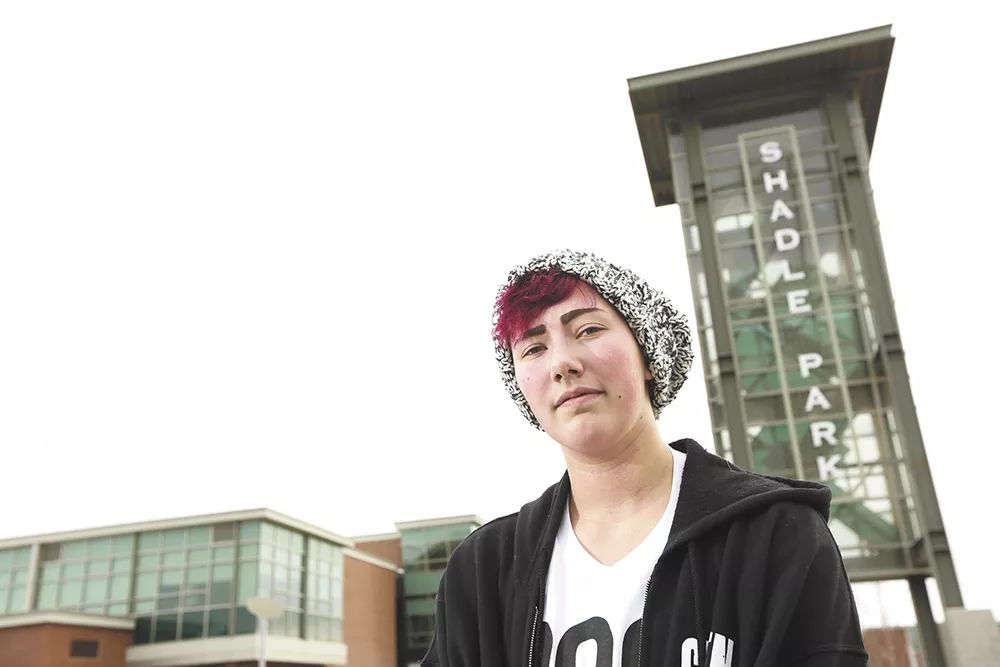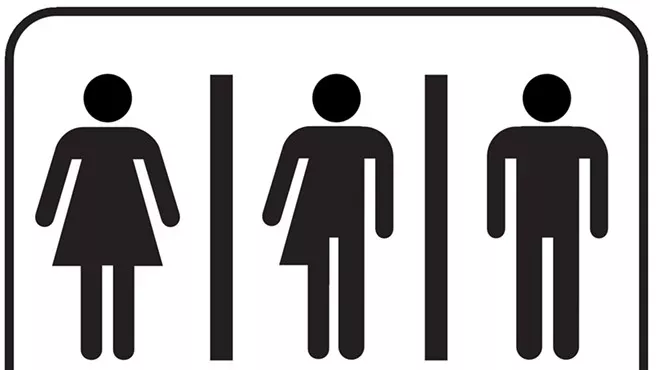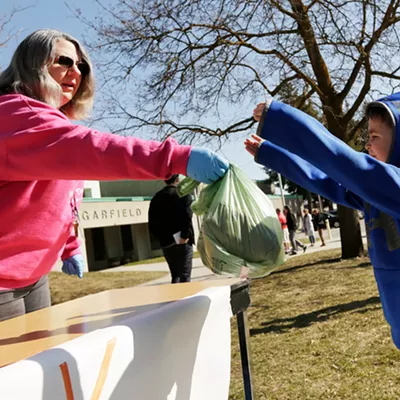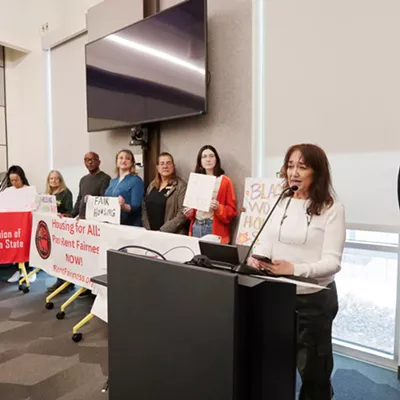
On the second day of school at Spokane's Stevens Elementary, Betsy White was called in because her child had said something that the principal found "disturbing." White's kindergartener, Trey, wanted to be called "she."
When school officials asked her what to do about it, White says she offered a simple solution: Call her "she."
White's daughter, now 8, is a transgender girl named Rachel. White says that as soon as her daughter could choose for herself, she gravitated to more feminine clothes and toys. She even recalls a time when Rachel was 2 and she hung a plastic garbage bag over her shoulders like a dress, put on her sister's shoes and grabbed a purse.
"By the time she was in preschool at [age] 4, we thought she was flamboyantly gay," says White, who told that to the kindergarten teacher before Rachel came out as transgender. "We were already kind of in the ballpark, we just didn't get the bigger picture until the second day of kindergarten."
For schools, having transgender students can be more complicated than deciding which pronouns to use. Districts must decide if transgender students should be called by their chosen name, if they play boys or girls sports and which bathrooms they can use. Recently, the bathroom issue has been a point of contention in Washington state, after lawmakers rejected a bill that would have banned transgender people from using public bathrooms and restrooms consistent with their gender identity.
In November, Spokane Public Schools approved guidelines for transgender students. The Coeur d'Alene School District did so in July 2014. Many other districts in Washington and Idaho, however, have not. Some have refused to adopt guidelines, some haven't discussed them at all, and some have tabled discussions after policies were met with disapproval from worried parents.
Jude McNeil, executive director at Odyssey Youth Movement, a local LGBT advocacy organization, says it's critical for school districts to have guidelines in place so that teachers, counselors or administrators don't unintentionally harm transgender students because they are misinformed, or because they don't understand a particular policy.
"[Districts] think that addressing concerns and addressing safety for transgender students is somehow political, and they're worried about a backlash," McNeil says. "But the people who are suffering the consequences are transgender students."
TRANSGENDER RIGHTS
Ramon Alvarez, support and conciliation manager with Spokane Public Schools, anticipated some complaints when the school board adopted a policy regarding transgender students in November. Yet so far, he's only heard from people who support it.
The policy states that school employees should meet with transgender or gender-nonconforming students regarding how they would like to be addressed in class. It also states that students will be allowed to use the restroom corresponding with their gender identity, and that, generally, transgender students can use the locker rooms consistent with their identity as well.
"What I have heard from staff is that it is really helpful to have something in writing that they can reference, and they can use as a guide," Alvarez says.
Jojo Hunt, 15, says having support from his teachers means a lot. Hunt says he realized he was not a girl in middle school, but kept his mouth shut for a year. He came out as transgender to his friends in the eighth grade. As a freshman at Shadle Park High School, Hunt met with counselors and teachers in private, and told them he was a transgender male when school started. They have recognized him as a boy ever since.
"It means they respect me," Hunt says. "If they give me respect, I give them respect back. That's how it works."
Spokane's policy resembles transgender guidelines from the state Office of Superintendent of Public Instruction outlined in 2012. Washington also has an anti-discrimination law that protects transgender people.
Idaho, on the other hand, does not have the words "gender identity" or "sexual orientation" included in its state human rights law, although state Senate Democrats introduced a bill this year that would change that. Last July, Idaho's School Boards Association proposed LGBT guidelines that included protections for transgender students.
Matthew Handelman, Coeur d'Alene Public Schools superintendent, says it can be a challenge in public schools to determine when a student's rights start and another student's stop. The guidelines in Coeur d'Alene are similar to Spokane's, with one key difference. When it comes to restroom use, Coeur d'Alene schools say transgender students should not be required to use a locker room or restroom conflicting with their gender identity; however, in contrast to Spokane, the guidelines suggest such students use a private restroom or an alternative arrangement — not the restroom consistent with their identity.
Most districts in the Inland Northwest, like Mead and Central Valley, don't have a written transgender policy. Instead, says Jared Hoadley, Mead's executive director for student services, "it basically has been working with individual students to see how they can be successful."
In Colville, the school board discussed crafting a procedure in November that, among other suggestions, would allow transgender students to use the restroom consistent with their gender identity. Hundreds of parents showed up to the board meeting in opposition. After hearing from parents, the school board decided at its next meeting to table the policy until the board heard back from a district nondiscrimination task force — a process that likely will take several months.
Scott Martin was one of the parents speaking in opposition to that policy. For Martin, and many other parents who spoke, it comes down to their personal belief that transgender students remain the sex of their birth. Martin says that allowing transgender students to choose a bathroom is a "special right" that takes away rights of others.
"These are the morals that we want our children to understand and to carry throughout their lives," Martin says. He would suggest that transgender students use the bathroom, locker room, changing room or sleeping room that corresponds with their birth sex.
"We feel the school should handle a transgender student in class just like any other student," he says.
A SAFETY ISSUE
More than 40 percent of transgender people report attempting suicide, according to a 2011 report by the National Transgender Discrimination Survey. Another report by the Gay, Lesbian and Straight Education Network says that 80 percent of transgender students reported feeling unsafe at school because of their gender expression. In 2015, at least 21 transgender people were murdered in the United States — the highest number ever recorded in one year, according to the Human Rights Campaign.
When White is reminded of these numbers, she almost starts crying.
"I will do whatever it takes to not have my child become one of those statistics that everybody talks about," she says.
White remembers "freaking out" internally when Rachel first came out as transgender. After that, another one of White's five children, Faith, 11, came out as genderqueer — a person who does not identify with any gender. White admits that when Faith told her that, she thought Faith was acting out. Then White says she realized what she was doing. "I [was] saying to my child what I advocate for parents not to do," she says.
White says she realized she had two choices: support her children, or bury them.
White can tell when Rachel is being bullied at school. She comes home and lashes out. A few weeks ago, Faith fought with a boy who was teasing Rachel after school, and the school disciplined Faith, White says.
McNeil, from Odyssey Youth Movement, says the whole point in districts adopting transgender best practices is for schools to be safe for all students.
"There's always a lot of concern about safety," McNeil says. "The policy like Spokane Public Schools adopted, the purpose of it is to address real safety concerns, and that the school district is just as concerned about student safety as everyone else is."
At Shadle, Hunt uses the boys bathroom and says he hasn't been bullied much at all. Any issues he had there were during the first few weeks, when classmates would whisper after the teacher referred to Hunt as a male.
It's when he uses the men's bathroom outside of school that more people stare at him.
"The whole concept can be really confusing to people," Hunt says. "I don't think people really understand how you can feel that way about yourself, because I've had a lot of people say to me, 'But you're a girl.' I guess they don't understand how you can think you're a different gender."
He just hopes that someday being transgender won't be an issue at all.
"I wish I could just live a normal life without getting questions," Hunt says. "Because I get questions asked about me every day." ♦






















